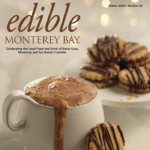Food Philosophy
A farmer, a vintner and a food artisan illuminate their crafts
Interviews by Zoe Gregozek
Illustrations by Lucy Conklin
Tabitha Stroup, owner and chef, Friend in Cheeses Jam Co.
What was your biggest jam disaster?
It was when I was first producing my own pectin. It was about two and a half years ago when I was starting. I had a very large order late at night, and I had almost 120 cases not set up. That’s almost 2,000 jars. And the truck was coming the next day. You wanna talk about a heart attack! I just did not get my formula correct because I was utilizing apples, and Mother Nature gave me the bird. I sent an e-mail to my brand-new distributor, and I pretty much begged for a 48-hour extension and told him the truth. I was able to save all the product. It just cost me the time and the re-cooking and the re-sterilization of the jars. I had to throw away the [original] lids. It was a big lesson. Do not go full bore into something if you are just becoming acquainted with a new formula, and that’s what I did. My ego got in front of me. I had never made such a large amount before. Mother Nature just told me what was up. I learned. I was put in my place, and it’s never happened again. It was probably my biggest oh-my-effing-God disaster. I threw up in the garbage can when I realized nothing was setting up.
What are your favorite jam ideas that are too crazy to sell?
I do an avocado curd that is off the chain. I do not think the public will get it. Beyond small microfood communities, it’s not gonna fly… even though in the deep South, they have avocado pie.
Lisa Knutson, the woman behind Pasture Chick Ranch
What is the grossest thing that you have ever had to put your hand into?
Do you really want to know that? A prolapsed chicken’s vent. I got you! In essence, the chicken has difficulty laying the egg and everything in her insides comes out with it, poo and everything else if the egg is too big. It’s very disgusting. Or it could be an abscess on the jaw of a goat where a stick got lodged in their tooth and it was green and disgusting. I’m gonna win this! I have to put my hand in really gross stuff. I live on a farm. It might gross people out in a food magazine. Can you save a prolapsed chicken? Yeah! I saved her; you have to flush her and rearrange all the tissue and put her where she can’t get injured. She survived.
Randall Grahm, winemaker and president for life, Bonny Doon Vineyard
What it the most meaningless wine term you’ve ever heard?
Where to start? Oh, my God. How about 98 points? That’s a meaningless term. By extension, giving wine numerical points is meaningless. That’s exceptionally, exceptionally meaningless. Because quality of wine is so subjective and so contextual and so much dependent on a million varieties, you can’t talk about what is a great wine. They say there is no such thing as great wine, there are only great bottles, and you could probably argue there are only great glasses or great sips or great tastes. Wine is a moving target, always moving.
Are you for or against wine in a box?
That’s actually a complex question. It’s a deceptively simple question, but it’s actually complex. On the one hand, I support the ecological aspects of wine in a box, less packaging, less carbon footprint, all of that is good. It also potentially makes wine more available and lowers the barrier of entry. The only issue has been the technical one whereby, at least until recently, maybe it’s changed, at least as far as a while ago, you were obliged to add more sulfur to the wine to keep an equivalent amount of shelf life to the wine. That’s potentially problematic because that impacts the quality in a negative way. So in other words, wine in a box is never quite as good as wine in a bottle. That’s the only real reservation I have. If you’re obliged to use high levels of sulfur, it has a negative impact on the taste. So like everything else in life, it’s a tradeoff.
Zoe Gregozek attends Georgiana Bruce Kirby Preparatory School in Santa Cruz.
About the author
At Edible Monterey Bay, our mission is to celebrate the local food culture of Santa Cruz, San Benito and Monterey Counties, season by season. We believe in sustainability, and we believe everyone has a right to healthful, clean and affordable food. We think knowing where our food comes from is powerful, and we hope our magazine, website and newsletters inspire readers to get to know and support our local growers, fishers, chefs, vintners and food artisans.
- Edible Monterey Bayhttps://www.ediblemontereybay.com/author/ediblemontereybay/
- Edible Monterey Bayhttps://www.ediblemontereybay.com/author/ediblemontereybay/
- Edible Monterey Bayhttps://www.ediblemontereybay.com/author/ediblemontereybay/
- Edible Monterey Bayhttps://www.ediblemontereybay.com/author/ediblemontereybay/






